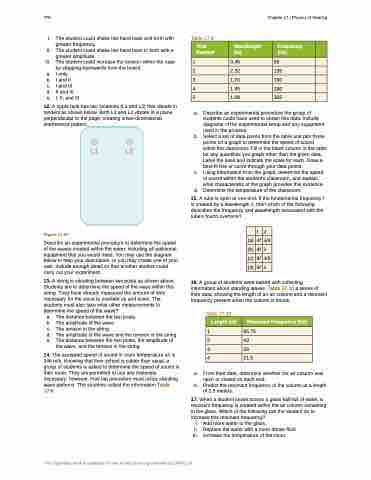Page 790 - College Physics For AP Courses
P. 790
778
Chapter 17 | Physics of Hearing
I. The student could shake her hand back and forth with greater frequency.
II. The student could shake her hand back in forth with a greater amplitude.
III. The student could increase the tension within the rope by stepping backwards from the board.
a. I only
b. I and II
c. I and III
d. II and III
e. I, II, and III
12. A ripple tank has two locations (L1 and L2) that vibrate in tandem as shown below. Both L1 and L2 vibrate in a plane perpendicular to the page, creating a two-dimensional interference pattern.
Figure 17.57
Describe an experimental procedure to determine the speed of the waves created within the water, including all additional equipment that you would need. You may use the diagram below to help your description, or you may create one of your own. Include enough detail so that another student could carry out your experiment.
13. A string is vibrating between two posts as shown above. Students are to determine the speed of the wave within this string. They have already measured the amount of time necessary for the wave to oscillate up and down. The students must also take what other measurements to determine the speed of the wave?
a. The distance between the two posts.
b. The amplitude of the wave
c. The tension in the string
d. The amplitude of the wave and the tension in the string
e. The distance between the two posts, the amplitude of
the wave, and the tension in the string
14. The accepted speed of sound in room temperature air is 346 m/s. Knowing that their school is colder than usual, a group of students is asked to determine the speed of sound in their room. They are permitted to use any materials necessary; however, their lab procedure must utilize standing wave patterns. The students collect the information Table 17.9.
Table 17.9
a. Describe an experimental procedure the group of students could have used to obtain this data. Include diagrams of the experimental setup and any equipment used in the process.
b. Select a set of data points from the table and plot those points on a graph to determine the speed of sound within the classroom. Fill in the blank column in the table for any quantities you graph other than the given data. Label the axes and indicate the scale for each. Draw a best-fit line or curve through your data points.
c. Using information from the graph, determine the speed of sound within the student’s classroom, and explain what characteristic of the graph provides this evidence.
d. Determine the temperature of the classroom.
15. A tube is open at one end. If the fundamental frequency f is created by a wavelength λ, then which of the following describes the frequency and wavelength associated with the tube’s fourth overtone?
16. A group of students were tasked with collecting information about standing waves. Table 17.10 a series of their data, showing the length of an air column and a resonant frequency present when the column is struck.
Trial Wavelength Frequency Number (m) (Hz)
1 3.45 95
2 2.32 135
3 1.70 190
4 1.45 240
5 1.08 305
Length (m) Resonant Frequency (Hz)
1 85.75
2 43
3 29
4 21.5
This OpenStax book is available for free at http://cnx.org/content/col11844/1.14
a. b.
Table 17.10
From their data, determine whether the air column was open or closed on each end.
Predict the resonant frequency of the column at a length of 2.5 meters.
fλ
(a) 4f λ/4
(b) 4f λ
(c) 9f λ/9
(d) 9f λ
17. When a student blows across a glass half-full of water, a resonant frequency is created within the air column remaining in the glass. Which of the following can the student do to increase this resonant frequency?
I. Add more water to the glass.
II. Replace the water with a more dense fluid.
III. Increase the temperature of the room.


